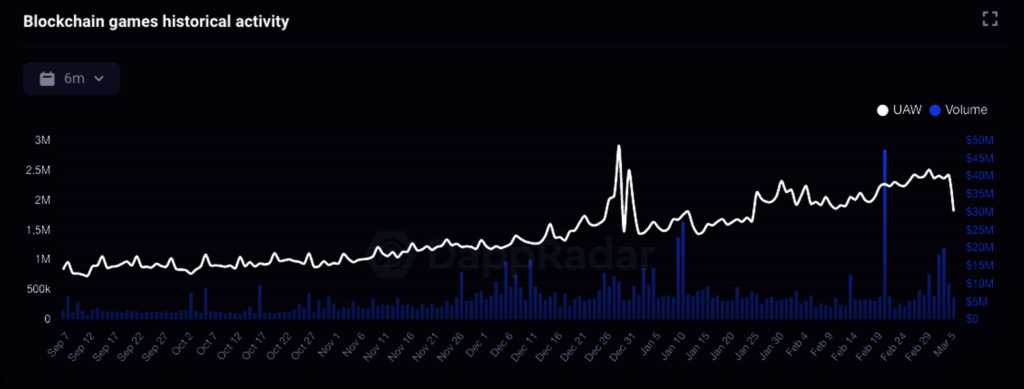The last three months of 2023 saw nearly 1 million unique active wallets participate in NFT video games. In 2024, this number could grow to hundreds of millions of active NFT players given that the majority of games in the previous year were beta versions, and are set to release complete versions this year.

1M unique active wallets in blockchain gaming in 3 months, data by DappRadar
Thanks to NFT integration, a game like Chainers has already attracted hundreds of thousands of worldwide players who want a world-class Web3 gaming experience. As per data from DappRadar, these players have minted millions of NFTs since the launch of Chainers one year ago.
But there are more reasons why gamers are flooding the Web3 space, and one of them is the allure of a play-to-earn(P2E) model. This article covers essential information every gamer should know, including NFTs in a gaming context, prerequisites for gaming in Web3, and NFT gaming models like P2E.
- NFT video game models
- The role of NFTs in monetizing gameplay
- Prerequisites for getting started in NFT gaming
- Emerging narratives in NFT video games
NFT Video Game Models
There are 8 gaming models in Web3. The list includes Play-to-Earn (P2E), Play-to-Play (P2P), Move-to-Earn (M2E), Free-to-Own (F2O), X_activity-to-Earn (X2O), Free-to-Play (F2P), Play-to-Own (P2O), and Learn-to-Earn (L2E). The goal of each of these models is to benefit the player in some way by either rewarding them with NFTs for their gameplay, enabling one to own a digital collectible, or even supporting the trade of these collectibles on a secondary marketplace.
The Role of Non-fungible Tokens (NFTs) in Gaming
NFTs in gaming include tradeable wearables, avatars, items such as swords, creatures like the Alien Axies in Axie Infinity, accessories, or crypto art. Incorporating NFTs into these items allows monetary value to flow throughout the game such that a player can purchase any of the mentioned items from other buyers, find them in a loot box, or trade their collectibles for crypto on an NFT marketplace like OpenSea.
Prerequisites for Getting Started in Web3
These are a smartphone or a gaming PC, a reliable internet connection, and a cryptocurrency wallet.
The industry misses out on potential gamers due to the requirement of having a wallet. Not everyone is Web 3.0 savvy enough to jump straight into crypto wallets and blockchain lingo, but we can admit opening a wallet is not as hard as you might think. The reason you need a wallet is for storing your digital assets or connecting to a marketplace when buying and selling the in-game assets.
In addition, you might require some basic Web 3.0 knowledge, which you can easily cover in 10 – 15 minutes. These may be what is NFT, how to use a marketplace, connect your wallet, deposit or withdraw funds, and secure your holdings.
Renting or Lending In-game NFT Assets
Borrowing and Lending in DEFI has crossed over to the Web 3.0 gaming ecosystem. This has enabled players to accumulate non-fungible tokens and make money by renting them to other players. For this reason, one does not have to necessarily sell their collectibles but can instead lend them out and make money. Also, players will benefit a lot if they have the option of borrowing in-game assets instead of having to purchase them whenever they need to play. This is particularly an advantage to those starting in NFT video games.
Emerging Narratives around NFT Gaming
Dynamic NFTs, user-generated content (UGC), ordinals, and the Apple VR Headset.
Dynamic Non-fungible Tokens (NFTs)
A dynamic non-fungible token can evolve or alter itself over time to inherit different attributes. These evolutions and changes also alter the NFT’s metadata, which may contain details like name, description, and features.
One of the attributes that make dynamic NFTs good for gaming is their interactivity, which has enabled developers to create immersive experiences.
User-generated Content (UGC)
User-generated content (UGC) rose to popularity at the height of Web 2.0 as an ingenious marketing strategy. Today, UGC is becoming an integral part of Web 3.0 gaming, where players can design their own characters, build their NFT metaverse spaces, and even drive demand for their digital creations. In 2024, the industry is looking forward to the return of celebrities in elevating engagement with gaming audiences through user-generated content and entertainment.
Bitcoin Ordinals
Ordinals emerged in 2023 as a method of inscribing digital data, such as art or media, into Bitcoin. This means Bitcoin NFTs are already here, and one of their characteristics is their ability to be divisible. As such, gamers with expensive digital collectibles can split a wearable or an avatar into several tradeable pieces and sell each of them in the secondary marketplace. A hot feature like this one will ultimately create a pathway for retail investors to enter the gaming space and drive demand for collectibles.
Apple Vision Pro and Meta Quest 3
The Apple virtual reality headset has the potential to revolutionize the NFT gaming ecosystem with its mixed-reality features. Many experts, including Animoca Brands founder Yat Siu, have predicted that the Apple VR headset will transform how creators design the metaverse and other vital virtual spaces in the NFT gaming space.
Meta, which has a fast-mover advantage over Apple with its Quest VR headsets, also released the Quest 3 VR gear.
Conclusion
The gaming sector has recorded significant advancement over the years from arcade machines, the invention of the PLATO network system, the emergence of the LAN party, and now we have the blockchain, non-fungible tokens, and ordinals. NFTs are redefining ownership in gaming and enabling many enthusiasts to transition into full-time playing since they can now make a living by winning rewards, trading collectibles, and creating digital assets that have monetary value.
Chainers, one of the rising stars in NFT gaming, has already attracted over 350,000 players who have minted more than 23 million non-fungible tokens. One of the reasons why the game has attracted such a large user base lies in its genius combination of a fan gameplay, and rewarding gaming experience.
As the gaming ecosystem continues to grow and evolve, we are yet to see more games like Chainers, or the integration of traditional games with non-fungible tokens. These will bring a lot of benefits to both players and studios: increased transparency, more revenue opportunities, and complete ownership.



